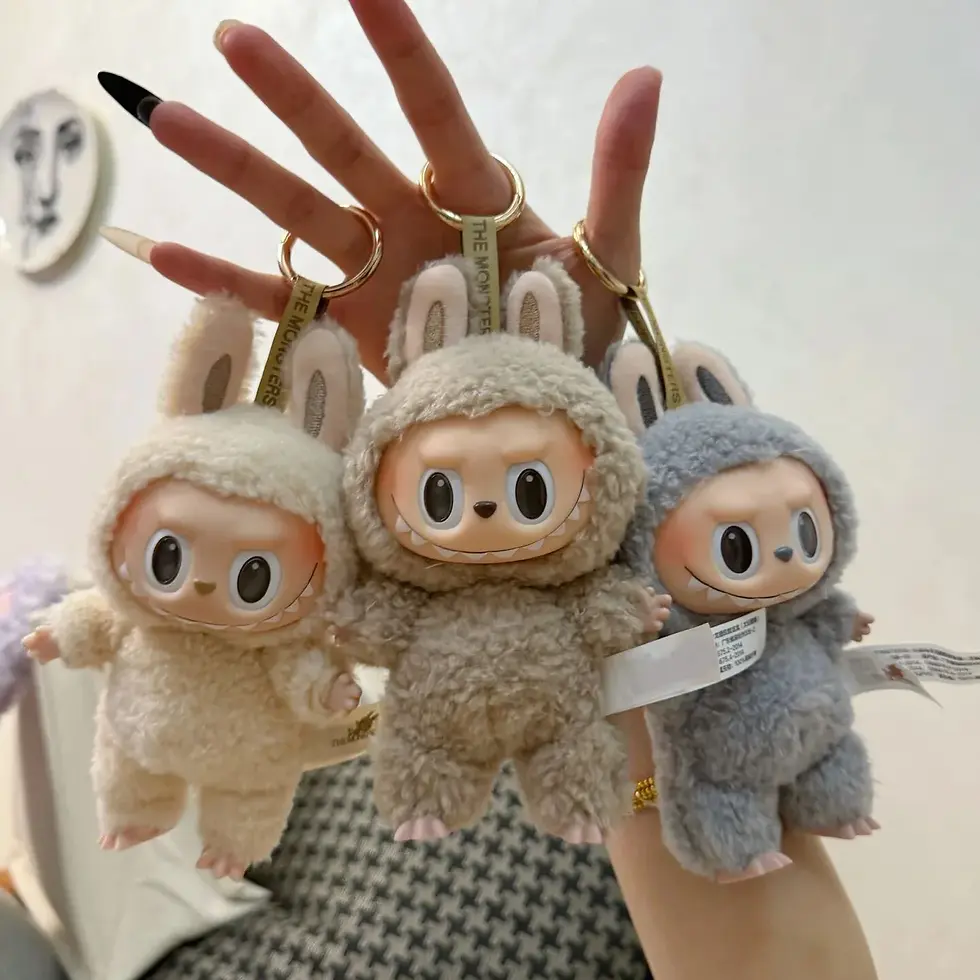Labubu Doll: The Viral Toy Everybody’s Talking About
- Anu Goel
- Aug 1
- 4 min read
If you’ve seen a mischievous fang-toothed creature popping up in celebrity selfies, influencer reels, and collector feeds, you’re not alone — Labubu dolls have become the must-have pop toy of this era.

Let’s explore everything about Labubu: from its intriguing history and design to scary myths, sky-high prices, and its global craze.
Origin, Designer & History
The Labubu doll design originates from the creative vision of Hong Kong-born artist Kasing Lung, who first introduced the character in 2015 within his illustrated book series "The Monsters." Lung’s design is heavily inspired by Nordic folklore and fairy tales—particularly stories about elves and forest spirits he encountered growing up in the Netherlands.
This influence is clear in Labubu’s distinct appearance: pointed ears, large shiny eyes, a wide mischievous grin, and sharp teeth, all of which evoke the magical, playful, and sometimes mysterious qualities of traditional Scandinavian elf and sprite legends.
The Labubu was developed as a sketchbook character, evolving through storybooks before becoming a designer toy when Kasing Lung partnered with the Chinese company Pop Mart in 2019. This collaboration propelled the figure into global pop culture, with the toys' quirky look and engaging backstory captivating both children and adult collectors worldwide.
To summarize the core design origins:
Creator: Kasing Lung

First appearance: 2015, in "The Monsters" story series
Key influences: Nordic folklore, elves, forest spirits, and Lung’s experiences blending Asian and European cultures
Distinct features: Pointed elfin ears, sharp teeth, big smile, large expressive eyes
Significance: Embodies the wonder and mischief of mythological forest beings, updated for a modern audience.
Despite rumors connecting Labubu to darker myths (such as the demon Pazuzu), experts and the creator confirm the character was always intended as a playful, creative tribute to magical tales—not anything sinister.
Appearance & Significance
Labubu dolls are famous for their large, pointed ears, sharp “devilish” teeth, expressive shiny eyes, and wide grins. The unique “ugly-cute” aesthetic — a blend of creepy and adorable — is instantly eye-catchin Labubu takes inspiration from elves and magical woodland creatures in Nordic legends, but modernizes them with playful street style and quirky outfits. These dolls come in various sizes and editions, often appearing in themed costumes, special collaborations, or event tie-ins.

Labubu isn’t just a character but a symbol of creativity, friendship, and the magic of fairytales — capturing the imagination of both children and adults.
Are Labubu Dolls Evil? The Truth Behind the Myth
Recently, a wave of online panic linked Labubu dolls to the ancient demon Pazuzu, sparked by viral posts, YouTube videos, and Instagram rumors. Some have shared urban legends of Labubu dolls causing “strange energy shifts” or creepy sounds, resulting in dolls being destroyed, burned, or thrown into rivers out of fear.

Fact check: There is zero evidence that Labubu dolls are evil, haunted, or cursed. These conspiracy theories emerged from social panic and misinterpretations of their unusual, mischievous look. The creator, Kasing Lung, and expert sources have repeatedly asserted Labubu’s innocent roots and playful purpose — nothing sinister or demonic.
Price, Cost, & Rarity
Labubu dolls come in many forms:
Blind box figures (9 cm): ₹1,800–₹3,300 (US$20–30)
MEGA Labubu figures (35 cm): ₹25,000–₹30,000 (US$300–400)
Rare/limited editions: Upwards of ₹1,00,000 (US$10,000+)
Most expensive ever: Mint-green human-sized Labubu sold for $150,000 at auction; special editions like the Labubu x Vans Old Skool have fetched $55,000–$100,000 on the secondary market.

The limited supply, blind-box format (you won’t know which figure you’ll get), frequent collaborations with brands like Vans, and viral social media moments (celebs like BLACKPINK’s Lisa, Kim Kardashian, and Rihanna flaunting their Labubus) have made rare editions ultra-desirable and drove prices upward.
Craze, Pop Culture, and Global Records

Originally cult favorites in Hong Kong and mainland China, Labubu dolls broke out thanks to K-pop icons in Korea and major celebrity endorsements. The dolls quickly surged in Southeast Asia, Japan, and Europe. In 2025, the Labubu phenomenon stormed into India and the U.S., driven by Gen Z and influencer culture.
Their “cute meets creepy” charm, TikTok/Instagram hype, and the thrill of collecting surprises appealed strongly to both youth and children, creating long waiting lists and fuel for the secondary market.
India: Labubu dolls have trended across content creator circles and Bollywood social feeds.
China, Korea, Japan, Southeast Asia: Pop Mart regularly sells out drops.
U.S. and Europe: Global collectors and luxury auctions have broken pricing records.
Labubu dolls have become more than a toy — they’re fashion statements, social media icons, and valuable collectibles. Each limited drop becomes a pop culture event.
Why Are They so Popular (and Expensive)?

Genuine creative design: Each figure is quirky, mischievous, and instantly recognizable
Social media virality: Celeb and influencer endorsement boosts hype
Blind box 'surprise' format: Increases thrill and collectibility
Limited editions and collabs: Supply remains small while demand surges
Storytelling and nostalgia: Taps into folk tales, nostalgia, and a love of the unique.
Final Thoughts

Labubu dolls are globally adored collectible toys blending folklore with fantastic design — not evil, but perfectly mischievous.
Their collector value, social media exposure, and cross-culture appeal have made some editions break international records, with high-end versions fetching small fortunes.
If you spot one on a shelf, online auction, or celebrity’s bag, know that this “ugly-cute” doll embodies one of the most powerful toy crazes of the last decade.




Comments